LAW 2202: Racism and the Macpherson Report Analysis
VerifiedAdded on 2022/09/09
|6
|1359
|15
Essay
AI Summary
This essay examines the prevalence of racism in the United Kingdom, focusing on the changes within the police service following the findings of the Macpherson Report. It provides a historical context, linking racism to the British Empire and the entrenched norms of the British class system. The essay discusses institutional racism as defined by Sir William Macpherson, highlighting the collective failure of organizations to provide professional services due to cultural or ethnic origins. It analyzes the impact of the Macpherson inquiry into the murder of Stephen Lawrence, which labeled the police response as institutionally racist, leading to seventy recommendations aimed at eradicating racist practices. The essay also explores the structural racism within the state, including immigration laws and the failure to address the legacy of the empire, and the subsequent increase in deaths of black people in police custody. The analysis underscores the significance of the Macpherson inquiry in confronting societal deficiencies and the need for reforms, discussing changes in practice, law, and detailed targets, along with the creation of the Independent Police Complaints Commission.
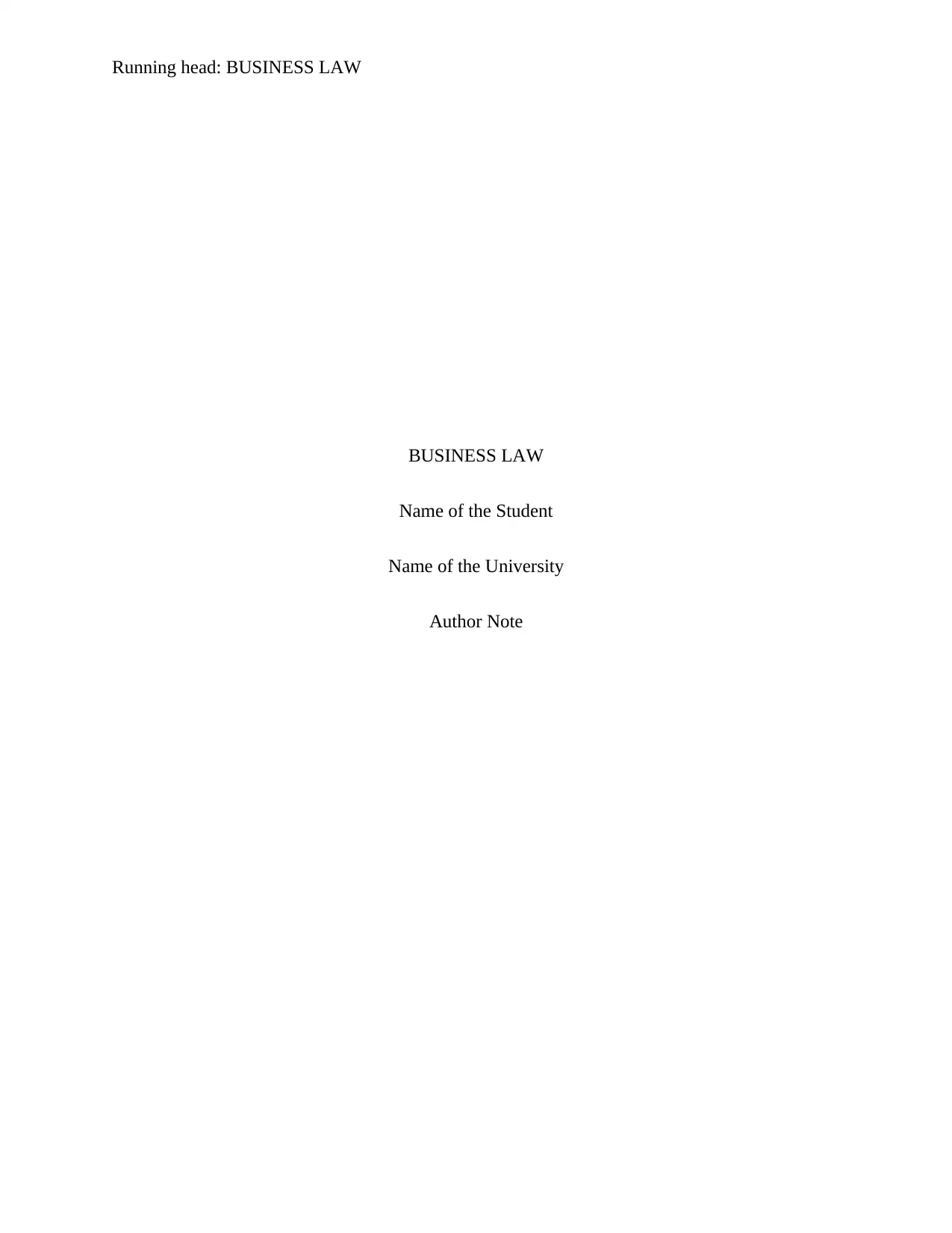
Running head: BUSINESS LAW
BUSINESS LAW
Name of the Student
Name of the University
Author Note
BUSINESS LAW
Name of the Student
Name of the University
Author Note
Paraphrase This Document
Need a fresh take? Get an instant paraphrase of this document with our AI Paraphraser
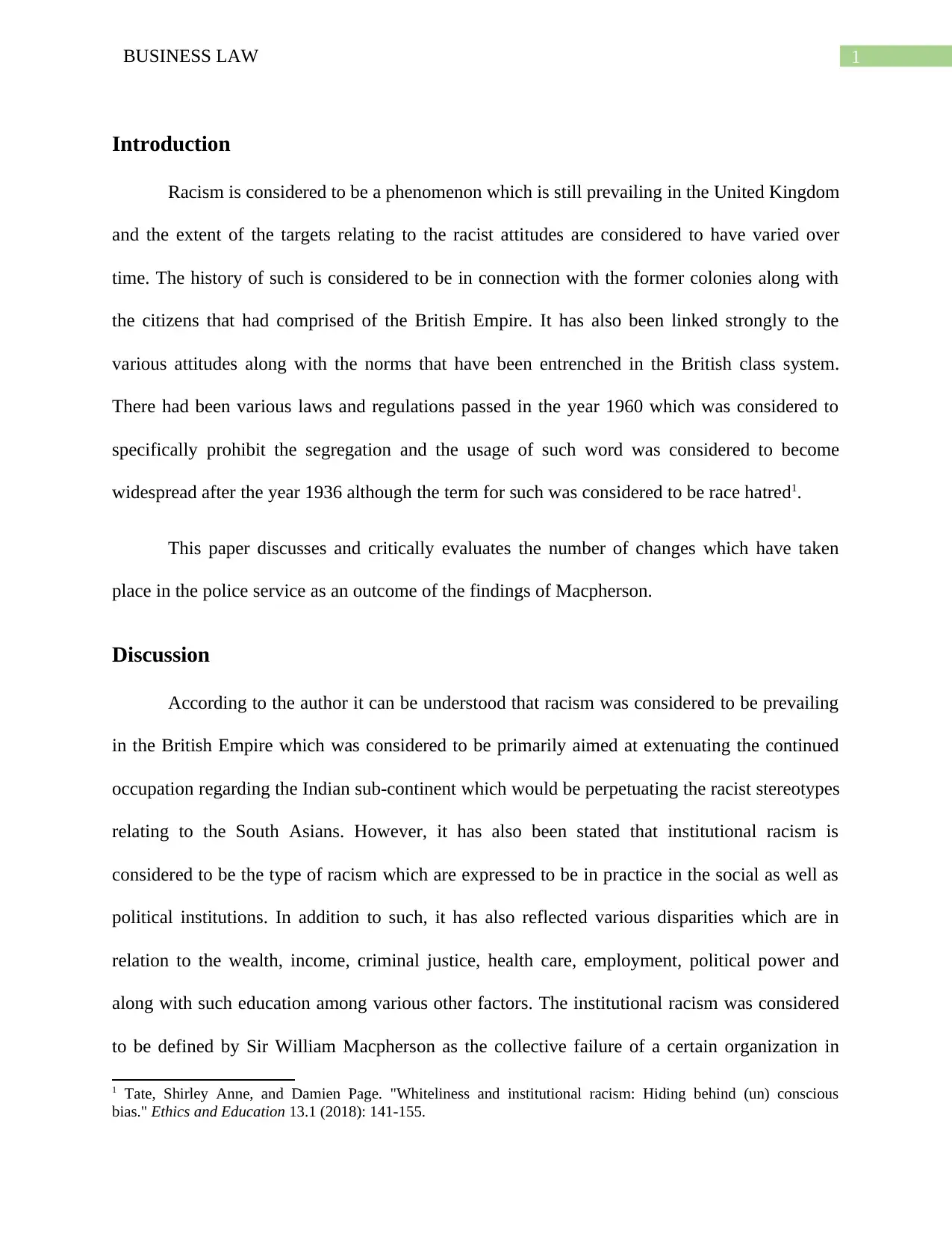
1BUSINESS LAW
Introduction
Racism is considered to be a phenomenon which is still prevailing in the United Kingdom
and the extent of the targets relating to the racist attitudes are considered to have varied over
time. The history of such is considered to be in connection with the former colonies along with
the citizens that had comprised of the British Empire. It has also been linked strongly to the
various attitudes along with the norms that have been entrenched in the British class system.
There had been various laws and regulations passed in the year 1960 which was considered to
specifically prohibit the segregation and the usage of such word was considered to become
widespread after the year 1936 although the term for such was considered to be race hatred1.
This paper discusses and critically evaluates the number of changes which have taken
place in the police service as an outcome of the findings of Macpherson.
Discussion
According to the author it can be understood that racism was considered to be prevailing
in the British Empire which was considered to be primarily aimed at extenuating the continued
occupation regarding the Indian sub-continent which would be perpetuating the racist stereotypes
relating to the South Asians. However, it has also been stated that institutional racism is
considered to be the type of racism which are expressed to be in practice in the social as well as
political institutions. In addition to such, it has also reflected various disparities which are in
relation to the wealth, income, criminal justice, health care, employment, political power and
along with such education among various other factors. The institutional racism was considered
to be defined by Sir William Macpherson as the collective failure of a certain organization in
1 Tate, Shirley Anne, and Damien Page. "Whiteliness and institutional racism: Hiding behind (un) conscious
bias." Ethics and Education 13.1 (2018): 141-155.
Introduction
Racism is considered to be a phenomenon which is still prevailing in the United Kingdom
and the extent of the targets relating to the racist attitudes are considered to have varied over
time. The history of such is considered to be in connection with the former colonies along with
the citizens that had comprised of the British Empire. It has also been linked strongly to the
various attitudes along with the norms that have been entrenched in the British class system.
There had been various laws and regulations passed in the year 1960 which was considered to
specifically prohibit the segregation and the usage of such word was considered to become
widespread after the year 1936 although the term for such was considered to be race hatred1.
This paper discusses and critically evaluates the number of changes which have taken
place in the police service as an outcome of the findings of Macpherson.
Discussion
According to the author it can be understood that racism was considered to be prevailing
in the British Empire which was considered to be primarily aimed at extenuating the continued
occupation regarding the Indian sub-continent which would be perpetuating the racist stereotypes
relating to the South Asians. However, it has also been stated that institutional racism is
considered to be the type of racism which are expressed to be in practice in the social as well as
political institutions. In addition to such, it has also reflected various disparities which are in
relation to the wealth, income, criminal justice, health care, employment, political power and
along with such education among various other factors. The institutional racism was considered
to be defined by Sir William Macpherson as the collective failure of a certain organization in
1 Tate, Shirley Anne, and Damien Page. "Whiteliness and institutional racism: Hiding behind (un) conscious
bias." Ethics and Education 13.1 (2018): 141-155.
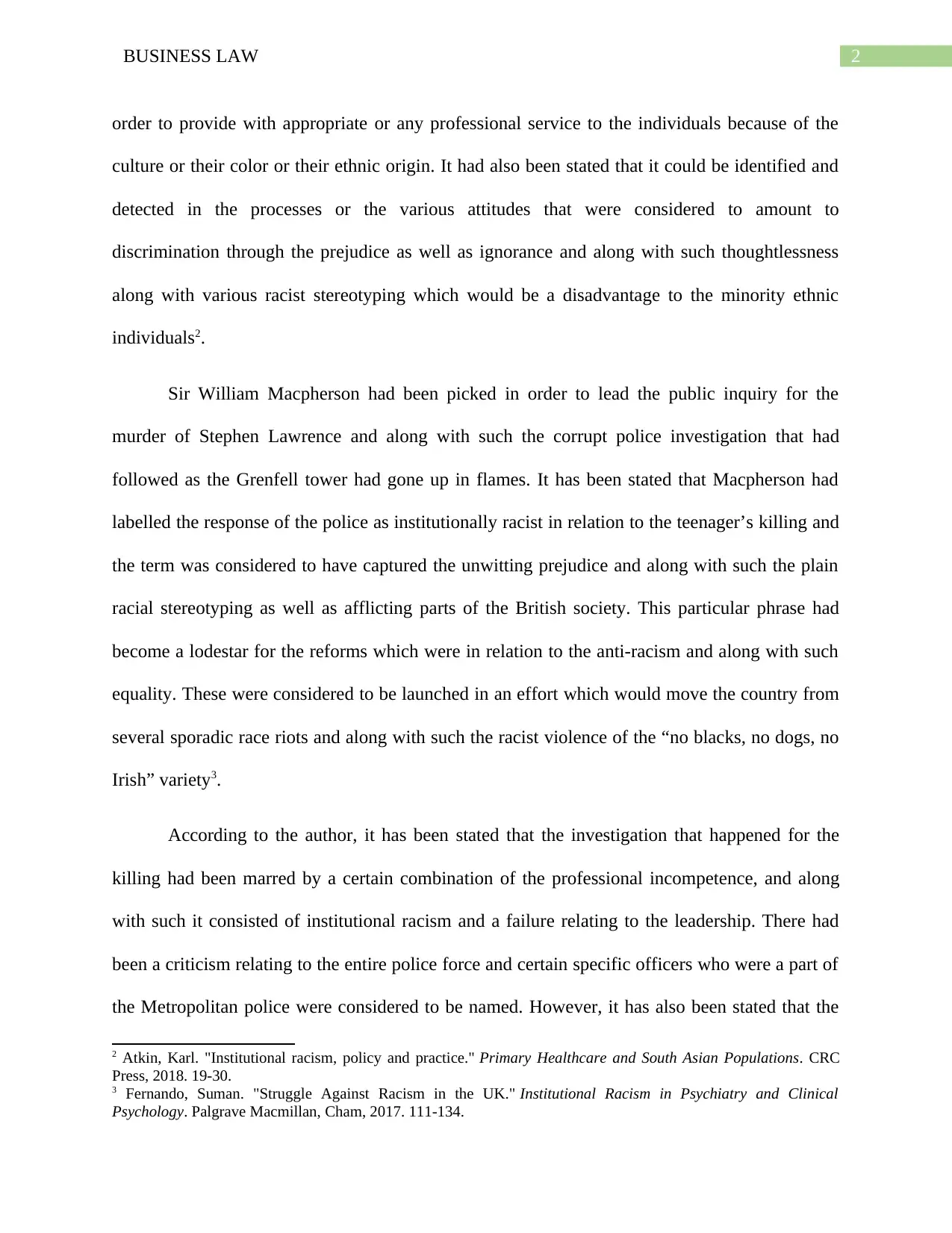
2BUSINESS LAW
order to provide with appropriate or any professional service to the individuals because of the
culture or their color or their ethnic origin. It had also been stated that it could be identified and
detected in the processes or the various attitudes that were considered to amount to
discrimination through the prejudice as well as ignorance and along with such thoughtlessness
along with various racist stereotyping which would be a disadvantage to the minority ethnic
individuals2.
Sir William Macpherson had been picked in order to lead the public inquiry for the
murder of Stephen Lawrence and along with such the corrupt police investigation that had
followed as the Grenfell tower had gone up in flames. It has been stated that Macpherson had
labelled the response of the police as institutionally racist in relation to the teenager’s killing and
the term was considered to have captured the unwitting prejudice and along with such the plain
racial stereotyping as well as afflicting parts of the British society. This particular phrase had
become a lodestar for the reforms which were in relation to the anti-racism and along with such
equality. These were considered to be launched in an effort which would move the country from
several sporadic race riots and along with such the racist violence of the “no blacks, no dogs, no
Irish” variety3.
According to the author, it has been stated that the investigation that happened for the
killing had been marred by a certain combination of the professional incompetence, and along
with such it consisted of institutional racism and a failure relating to the leadership. There had
been a criticism relating to the entire police force and certain specific officers who were a part of
the Metropolitan police were considered to be named. However, it has also been stated that the
2 Atkin, Karl. "Institutional racism, policy and practice." Primary Healthcare and South Asian Populations. CRC
Press, 2018. 19-30.
3 Fernando, Suman. "Struggle Against Racism in the UK." Institutional Racism in Psychiatry and Clinical
Psychology. Palgrave Macmillan, Cham, 2017. 111-134.
order to provide with appropriate or any professional service to the individuals because of the
culture or their color or their ethnic origin. It had also been stated that it could be identified and
detected in the processes or the various attitudes that were considered to amount to
discrimination through the prejudice as well as ignorance and along with such thoughtlessness
along with various racist stereotyping which would be a disadvantage to the minority ethnic
individuals2.
Sir William Macpherson had been picked in order to lead the public inquiry for the
murder of Stephen Lawrence and along with such the corrupt police investigation that had
followed as the Grenfell tower had gone up in flames. It has been stated that Macpherson had
labelled the response of the police as institutionally racist in relation to the teenager’s killing and
the term was considered to have captured the unwitting prejudice and along with such the plain
racial stereotyping as well as afflicting parts of the British society. This particular phrase had
become a lodestar for the reforms which were in relation to the anti-racism and along with such
equality. These were considered to be launched in an effort which would move the country from
several sporadic race riots and along with such the racist violence of the “no blacks, no dogs, no
Irish” variety3.
According to the author, it has been stated that the investigation that happened for the
killing had been marred by a certain combination of the professional incompetence, and along
with such it consisted of institutional racism and a failure relating to the leadership. There had
been a criticism relating to the entire police force and certain specific officers who were a part of
the Metropolitan police were considered to be named. However, it has also been stated that the
2 Atkin, Karl. "Institutional racism, policy and practice." Primary Healthcare and South Asian Populations. CRC
Press, 2018. 19-30.
3 Fernando, Suman. "Struggle Against Racism in the UK." Institutional Racism in Psychiatry and Clinical
Psychology. Palgrave Macmillan, Cham, 2017. 111-134.
⊘ This is a preview!⊘
Do you want full access?
Subscribe today to unlock all pages.

Trusted by 1+ million students worldwide
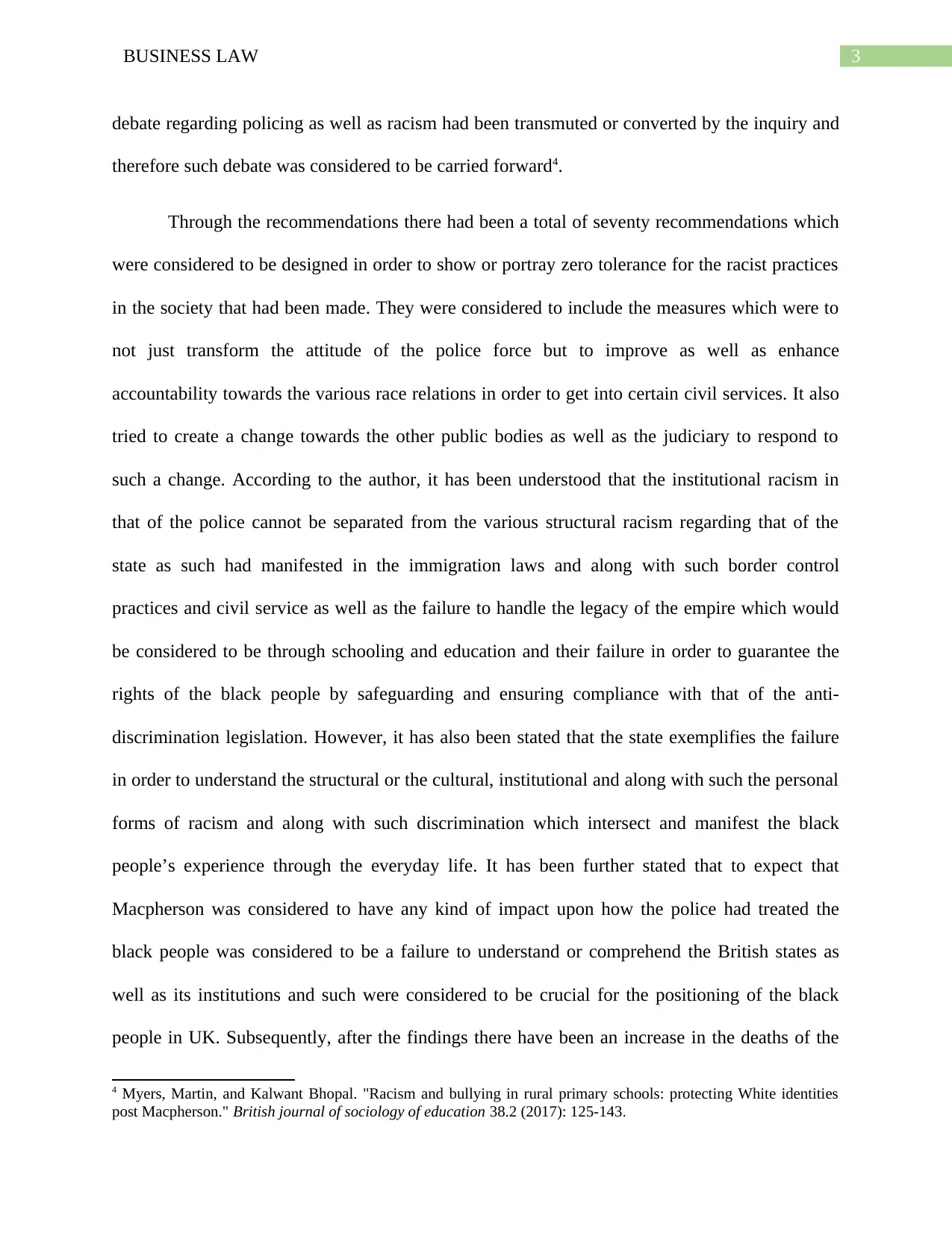
3BUSINESS LAW
debate regarding policing as well as racism had been transmuted or converted by the inquiry and
therefore such debate was considered to be carried forward4.
Through the recommendations there had been a total of seventy recommendations which
were considered to be designed in order to show or portray zero tolerance for the racist practices
in the society that had been made. They were considered to include the measures which were to
not just transform the attitude of the police force but to improve as well as enhance
accountability towards the various race relations in order to get into certain civil services. It also
tried to create a change towards the other public bodies as well as the judiciary to respond to
such a change. According to the author, it has been understood that the institutional racism in
that of the police cannot be separated from the various structural racism regarding that of the
state as such had manifested in the immigration laws and along with such border control
practices and civil service as well as the failure to handle the legacy of the empire which would
be considered to be through schooling and education and their failure in order to guarantee the
rights of the black people by safeguarding and ensuring compliance with that of the anti-
discrimination legislation. However, it has also been stated that the state exemplifies the failure
in order to understand the structural or the cultural, institutional and along with such the personal
forms of racism and along with such discrimination which intersect and manifest the black
people’s experience through the everyday life. It has been further stated that to expect that
Macpherson was considered to have any kind of impact upon how the police had treated the
black people was considered to be a failure to understand or comprehend the British states as
well as its institutions and such were considered to be crucial for the positioning of the black
people in UK. Subsequently, after the findings there have been an increase in the deaths of the
4 Myers, Martin, and Kalwant Bhopal. "Racism and bullying in rural primary schools: protecting White identities
post Macpherson." British journal of sociology of education 38.2 (2017): 125-143.
debate regarding policing as well as racism had been transmuted or converted by the inquiry and
therefore such debate was considered to be carried forward4.
Through the recommendations there had been a total of seventy recommendations which
were considered to be designed in order to show or portray zero tolerance for the racist practices
in the society that had been made. They were considered to include the measures which were to
not just transform the attitude of the police force but to improve as well as enhance
accountability towards the various race relations in order to get into certain civil services. It also
tried to create a change towards the other public bodies as well as the judiciary to respond to
such a change. According to the author, it has been understood that the institutional racism in
that of the police cannot be separated from the various structural racism regarding that of the
state as such had manifested in the immigration laws and along with such border control
practices and civil service as well as the failure to handle the legacy of the empire which would
be considered to be through schooling and education and their failure in order to guarantee the
rights of the black people by safeguarding and ensuring compliance with that of the anti-
discrimination legislation. However, it has also been stated that the state exemplifies the failure
in order to understand the structural or the cultural, institutional and along with such the personal
forms of racism and along with such discrimination which intersect and manifest the black
people’s experience through the everyday life. It has been further stated that to expect that
Macpherson was considered to have any kind of impact upon how the police had treated the
black people was considered to be a failure to understand or comprehend the British states as
well as its institutions and such were considered to be crucial for the positioning of the black
people in UK. Subsequently, after the findings there have been an increase in the deaths of the
4 Myers, Martin, and Kalwant Bhopal. "Racism and bullying in rural primary schools: protecting White identities
post Macpherson." British journal of sociology of education 38.2 (2017): 125-143.
Paraphrase This Document
Need a fresh take? Get an instant paraphrase of this document with our AI Paraphraser
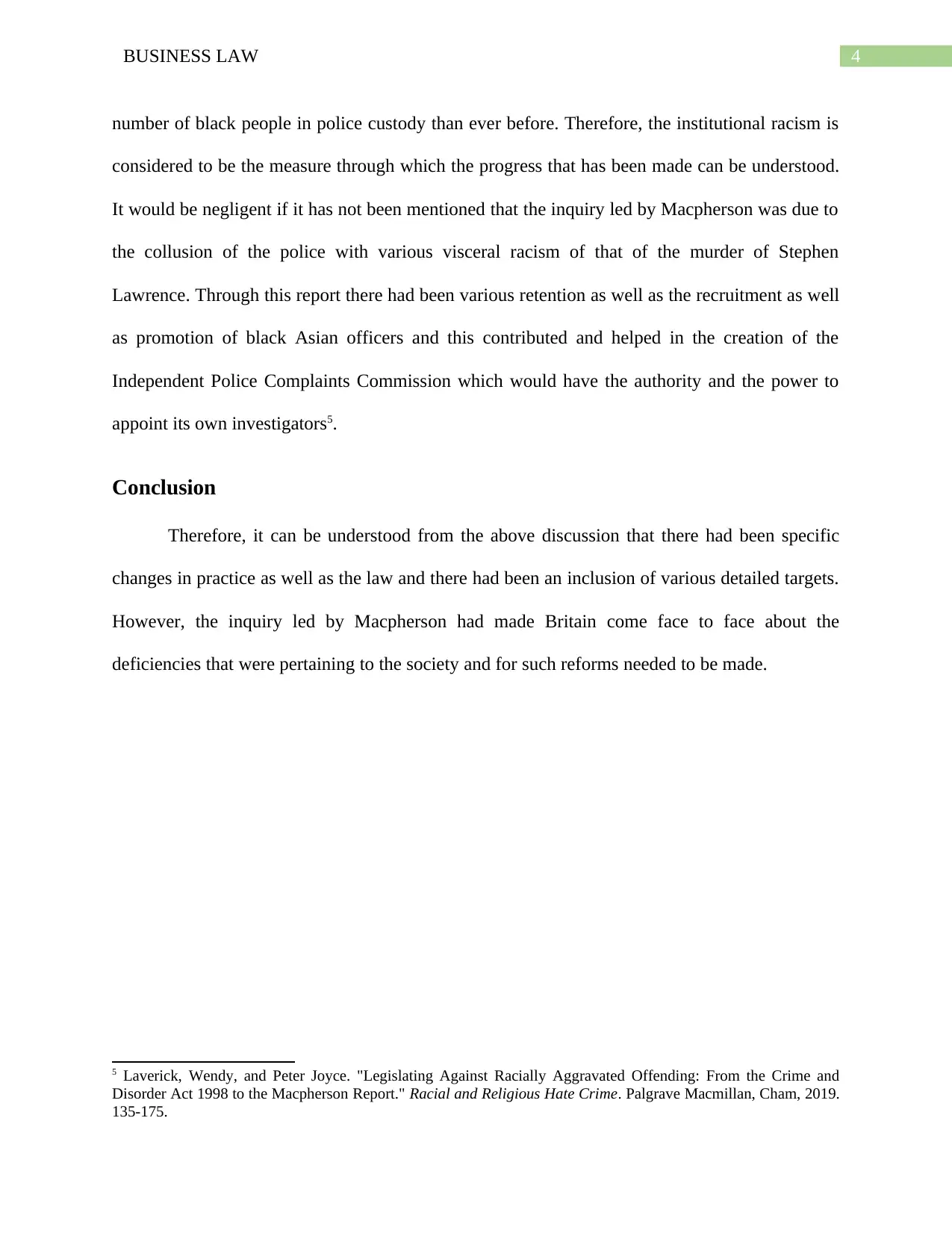
4BUSINESS LAW
number of black people in police custody than ever before. Therefore, the institutional racism is
considered to be the measure through which the progress that has been made can be understood.
It would be negligent if it has not been mentioned that the inquiry led by Macpherson was due to
the collusion of the police with various visceral racism of that of the murder of Stephen
Lawrence. Through this report there had been various retention as well as the recruitment as well
as promotion of black Asian officers and this contributed and helped in the creation of the
Independent Police Complaints Commission which would have the authority and the power to
appoint its own investigators5.
Conclusion
Therefore, it can be understood from the above discussion that there had been specific
changes in practice as well as the law and there had been an inclusion of various detailed targets.
However, the inquiry led by Macpherson had made Britain come face to face about the
deficiencies that were pertaining to the society and for such reforms needed to be made.
5 Laverick, Wendy, and Peter Joyce. "Legislating Against Racially Aggravated Offending: From the Crime and
Disorder Act 1998 to the Macpherson Report." Racial and Religious Hate Crime. Palgrave Macmillan, Cham, 2019.
135-175.
number of black people in police custody than ever before. Therefore, the institutional racism is
considered to be the measure through which the progress that has been made can be understood.
It would be negligent if it has not been mentioned that the inquiry led by Macpherson was due to
the collusion of the police with various visceral racism of that of the murder of Stephen
Lawrence. Through this report there had been various retention as well as the recruitment as well
as promotion of black Asian officers and this contributed and helped in the creation of the
Independent Police Complaints Commission which would have the authority and the power to
appoint its own investigators5.
Conclusion
Therefore, it can be understood from the above discussion that there had been specific
changes in practice as well as the law and there had been an inclusion of various detailed targets.
However, the inquiry led by Macpherson had made Britain come face to face about the
deficiencies that were pertaining to the society and for such reforms needed to be made.
5 Laverick, Wendy, and Peter Joyce. "Legislating Against Racially Aggravated Offending: From the Crime and
Disorder Act 1998 to the Macpherson Report." Racial and Religious Hate Crime. Palgrave Macmillan, Cham, 2019.
135-175.
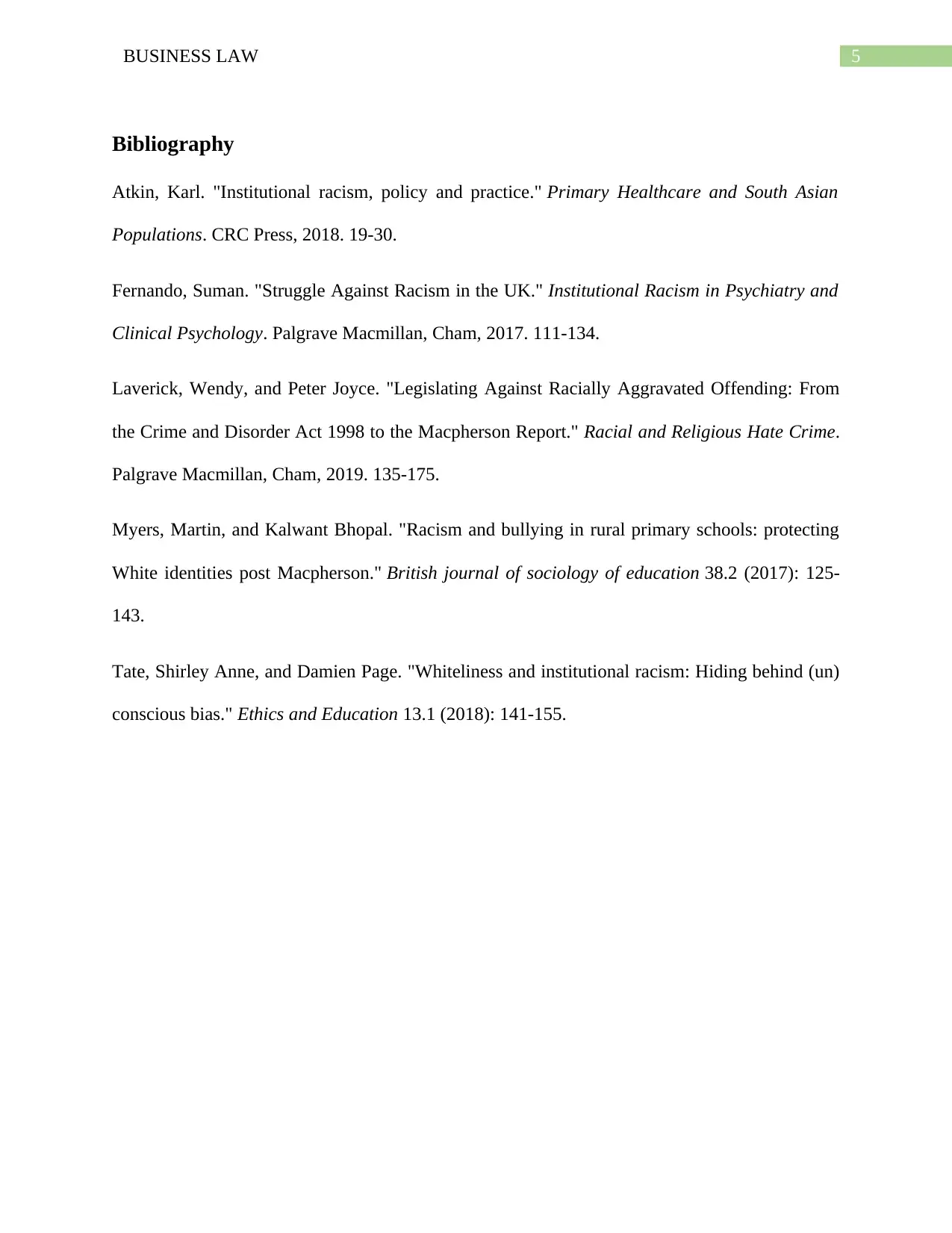
5BUSINESS LAW
Bibliography
Atkin, Karl. "Institutional racism, policy and practice." Primary Healthcare and South Asian
Populations. CRC Press, 2018. 19-30.
Fernando, Suman. "Struggle Against Racism in the UK." Institutional Racism in Psychiatry and
Clinical Psychology. Palgrave Macmillan, Cham, 2017. 111-134.
Laverick, Wendy, and Peter Joyce. "Legislating Against Racially Aggravated Offending: From
the Crime and Disorder Act 1998 to the Macpherson Report." Racial and Religious Hate Crime.
Palgrave Macmillan, Cham, 2019. 135-175.
Myers, Martin, and Kalwant Bhopal. "Racism and bullying in rural primary schools: protecting
White identities post Macpherson." British journal of sociology of education 38.2 (2017): 125-
143.
Tate, Shirley Anne, and Damien Page. "Whiteliness and institutional racism: Hiding behind (un)
conscious bias." Ethics and Education 13.1 (2018): 141-155.
Bibliography
Atkin, Karl. "Institutional racism, policy and practice." Primary Healthcare and South Asian
Populations. CRC Press, 2018. 19-30.
Fernando, Suman. "Struggle Against Racism in the UK." Institutional Racism in Psychiatry and
Clinical Psychology. Palgrave Macmillan, Cham, 2017. 111-134.
Laverick, Wendy, and Peter Joyce. "Legislating Against Racially Aggravated Offending: From
the Crime and Disorder Act 1998 to the Macpherson Report." Racial and Religious Hate Crime.
Palgrave Macmillan, Cham, 2019. 135-175.
Myers, Martin, and Kalwant Bhopal. "Racism and bullying in rural primary schools: protecting
White identities post Macpherson." British journal of sociology of education 38.2 (2017): 125-
143.
Tate, Shirley Anne, and Damien Page. "Whiteliness and institutional racism: Hiding behind (un)
conscious bias." Ethics and Education 13.1 (2018): 141-155.
⊘ This is a preview!⊘
Do you want full access?
Subscribe today to unlock all pages.

Trusted by 1+ million students worldwide
1 out of 6
Related Documents
Your All-in-One AI-Powered Toolkit for Academic Success.
+13062052269
info@desklib.com
Available 24*7 on WhatsApp / Email
![[object Object]](/_next/static/media/star-bottom.7253800d.svg)
Unlock your academic potential
Copyright © 2020–2025 A2Z Services. All Rights Reserved. Developed and managed by ZUCOL.





